|
The
history of Yangon is intertwined with the history of the Shwedagon Pagoda.
Wherever one may be in Yangon, in the busy town centre, in the new towns of the
east, in the industrial zone of the west, in the paddy fields of the north, the
golden form of the Shwedagon will be seen on the skyline rising above the
foliage of the tropical trees and buildings in the foreground.
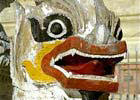 The
founding story of Shwedagon reaches back to the days of the ‘Enlightenment’
of Gaudama Buddha. It was on the 49th day after the ‘Enlightenment’ when two
brothers, Taphussa and Bhallika, merchants from Ukkalapa in the land of Mon
people in lower Myanmar, came before Buddha. Buddha passed his hand over his
head and obtaining eight hairs, gave them to the brothers. Buddha, perceiving
that three previous Buddhas had their possessions enshrined in a pagoda on
Singuttara hill in the country of the two brothers, bade them to do likewise
with the ‘sacred hairs’. The
founding story of Shwedagon reaches back to the days of the ‘Enlightenment’
of Gaudama Buddha. It was on the 49th day after the ‘Enlightenment’ when two
brothers, Taphussa and Bhallika, merchants from Ukkalapa in the land of Mon
people in lower Myanmar, came before Buddha. Buddha passed his hand over his
head and obtaining eight hairs, gave them to the brothers. Buddha, perceiving
that three previous Buddhas had their possessions enshrined in a pagoda on
Singuttara hill in the country of the two brothers, bade them to do likewise
with the ‘sacred hairs’.
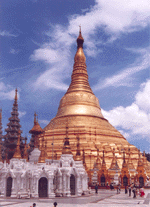 On
their return the king welcomed the hairs with great ceremony at Asitanzana,
north-west of present Yangon. No human knew the location of the previous
Buddha’s possessions but Sakka, King of the nats did and guided them to
Singuttara where Gautama Buddha's hairs were enshrined and a stupa consecrated
on the full moon day of Tabaung (March 6,c.588 B.C.) On
their return the king welcomed the hairs with great ceremony at Asitanzana,
north-west of present Yangon. No human knew the location of the previous
Buddha’s possessions but Sakka, King of the nats did and guided them to
Singuttara where Gautama Buddha's hairs were enshrined and a stupa consecrated
on the full moon day of Tabaung (March 6,c.588 B.C.)
Over
the years however it fell into ruin and was covered with jungle. Tradition
states that 200 years afterwards two monks from Sri Lanka brought King Asoka to
the Pagoda. The King had the jungle cleared and the Pagoda repaired.
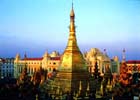 In
the fifth century A.D. King Duttabaung paid homage at the Pagoda and in the 11th
century, King Anawratha of Bagan offered gold and silver umbrellas and built a
pagoda near the town of Twante across the Yangon River. (Dalla, which is now a
town on the bank opposite Yangon, was then located on the Twante Ridge and was
more important than Dagon. Dagon at that time lay in low lying often
water-logged land. Sule Pagoda, now in downtown Yangon, stood on a small island
in the swamp, to the west down to he Hlaing River and Yangon /River to the south
.The Shwedagon (then called Kyak Lagun in Mon) was reached across a causeway.) In
the fifth century A.D. King Duttabaung paid homage at the Pagoda and in the 11th
century, King Anawratha of Bagan offered gold and silver umbrellas and built a
pagoda near the town of Twante across the Yangon River. (Dalla, which is now a
town on the bank opposite Yangon, was then located on the Twante Ridge and was
more important than Dagon. Dagon at that time lay in low lying often
water-logged land. Sule Pagoda, now in downtown Yangon, stood on a small island
in the swamp, to the west down to he Hlaing River and Yangon /River to the south
.The Shwedagon (then called Kyak Lagun in Mon) was reached across a causeway.)
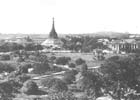 After
the collapse of Bagan in the 13th century and the rise of Mon power in the 14th
with the capital at Bago, Dagon became a place of some importance, though not as
a commercial port but as a centre of religious life. Dagon at that time was not
a walled city but a fort of logs. After
the collapse of Bagan in the 13th century and the rise of Mon power in the 14th
with the capital at Bago, Dagon became a place of some importance, though not as
a commercial port but as a centre of religious life. Dagon at that time was not
a walled city but a fort of logs.
Successive
Mon kings of the 15th century raised the height of Pagoda by encasing an earlier
pagoda and embellishing the new. King Binnyayan (1426-46) enlarged the base to
five terraces to sustain the height but before he could finish the work he died.
Binnyawaru (1446-50) his successor and his mother, Queen Shin Saw Bu, raised the
height of the Pagoda to 90.6 m.
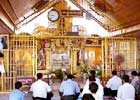 Queen
Shin Saw Bu was the first to gild the Pagoda. She donated her weight in
gold to its gilding process and dedicated a vast expanse of land which virtually
covered the whole of modern Yangon. Her successor King Dhammazedi created the
stone inscriptions standing on Pagoda Hill as well as donating a huge bell which
a Portugese adventurer took away only to fall into the river, never to be
recovered. In 1539, Tabinshwehti, who had conquered Bago, placed the jewelled
finish on the pagoda’s spire. Queen
Shin Saw Bu was the first to gild the Pagoda. She donated her weight in
gold to its gilding process and dedicated a vast expanse of land which virtually
covered the whole of modern Yangon. Her successor King Dhammazedi created the
stone inscriptions standing on Pagoda Hill as well as donating a huge bell which
a Portugese adventurer took away only to fall into the river, never to be
recovered. In 1539, Tabinshwehti, who had conquered Bago, placed the jewelled
finish on the pagoda’s spire.
In
1572, Bayinnaung rebuilt the Pagoda and had it re-gilded. The shrine had been
reduced to rubble during an earthquake in 1564.
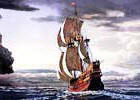 By
the end of the 16th century the Shwedagon Fair (by now an annual event) was
attracting people not only from Myanmar but also from distance lands such as
Laos and Cambodia. The Dagon Fair was one of the chief markets for overseas
trade rivalling Bago and Thanlyin. This and the fact that the Bago River was
silting up making it difficult for sea-going vessels to navigate, Dagon become
the port of choice. By
the end of the 16th century the Shwedagon Fair (by now an annual event) was
attracting people not only from Myanmar but also from distance lands such as
Laos and Cambodia. The Dagon Fair was one of the chief markets for overseas
trade rivalling Bago and Thanlyin. This and the fact that the Bago River was
silting up making it difficult for sea-going vessels to navigate, Dagon become
the port of choice.
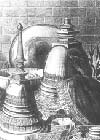 After
the founding of the Shwedagon Pagoda, Alaungpaya's conquest of lower Myanmar is
the second most important event in the history of Dagon. May 1775 marks the
beginning of the modern town when Alaungpaya, to commemorate his victory,
changed its name from Dagon to Yangon, "Enmity exhausted." After
the founding of the Shwedagon Pagoda, Alaungpaya's conquest of lower Myanmar is
the second most important event in the history of Dagon. May 1775 marks the
beginning of the modern town when Alaungpaya, to commemorate his victory,
changed its name from Dagon to Yangon, "Enmity exhausted."
Alaungpaya's
Yangon was basically a log fortress. The stockade was built of solid teak and
was protected by a ditch. The town had three streets running east-west and two
running north-south. The Sule Pagoda stood on a small pinnacle cut off from the
town by a swamp. Yangon itself stood on a small island surrounded by water at
high tide, In 1782, it was reported that the streets were not paved but by 1795
they were.
Shipbuilding
became a major industry and apart from construction, the shipyards did a busy
trade in refitting ships, becoming so adept at this that it alarmed the British
in India who felt that steps should be taken to curb its power, which they did.
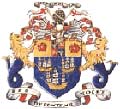 The
East India Company's government sent a combined force of nearly eleven thousand
men with forty pieces of artillery. On 10 May 1824 the fleet had anchored within
the bar upriver and landed on the 12th. The
East India Company's government sent a combined force of nearly eleven thousand
men with forty pieces of artillery. On 10 May 1824 the fleet had anchored within
the bar upriver and landed on the 12th.
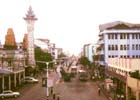 By
November, general Maha Bandoola arrived in the neighbourhood of Yangon. He made
several attempts to evict the invading force stationed on the Pagoda but was
frustrated by the guns of the enemy fleet. On the 15th, the Myanmar army was
driven from its stronghold and retreated towards Danubyu where an enemy shell
killed Maha Bandoola. By
November, general Maha Bandoola arrived in the neighbourhood of Yangon. He made
several attempts to evict the invading force stationed on the Pagoda but was
frustrated by the guns of the enemy fleet. On the 15th, the Myanmar army was
driven from its stronghold and retreated towards Danubyu where an enemy shell
killed Maha Bandoola.
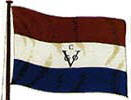 The
Treaty of Yandabo was concluded on 24th February 1826. Yangon remained in
occupation till 8th December. The invading force weighed anchor on 9th December
with a detachment left behind to receive the final instalment of the indemnity.
Yangon was returned to the Myowun by general Campbell. The
Treaty of Yandabo was concluded on 24th February 1826. Yangon remained in
occupation till 8th December. The invading force weighed anchor on 9th December
with a detachment left behind to receive the final instalment of the indemnity.
Yangon was returned to the Myowun by general Campbell.
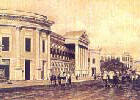 King
Thayawady decided that King Alaungpaya's town was too vulnerable to attack from
the river and that a new town should be built further inland, about a mile and a
quarter from the river. The Pagoda was worked into the defences of the town
and thus the Shwedagon formed the north-east corner of the town which was
named Aung Myei Aung Hnin, "Victory Soil, Victorious Ejector" King
Thayawady decided that King Alaungpaya's town was too vulnerable to attack from
the river and that a new town should be built further inland, about a mile and a
quarter from the river. The Pagoda was worked into the defences of the town
and thus the Shwedagon formed the north-east corner of the town which was
named Aung Myei Aung Hnin, "Victory Soil, Victorious Ejector"
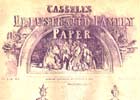 Though
King Thayawady's town was occupied for residence, the old Yangon continued to be
populous. Commerce and industry and all connected with trade and the port were
still situated there. In the end, King Alaungpaya's town existed for only
ten years and in 1852, lower Myanmar was annexed by the British and a new
Yangon was planned. Though
King Thayawady's town was occupied for residence, the old Yangon continued to be
populous. Commerce and industry and all connected with trade and the port were
still situated there. In the end, King Alaungpaya's town existed for only
ten years and in 1852, lower Myanmar was annexed by the British and a new
Yangon was planned.
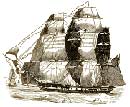 A
British force of 6000 men escorted by fifteen warships appeared at the mouth of
Yangon River on the 1st April 1852. On the 11th the ships crossed the bar and
took up position opposite the old town. The next day, Theinbyu, "the White
House Stockade" was taken. The British annexed lower Myanmar by a
proclamation dated 20th December 1852. On the 21st the proclamation was read in
Yangon. A
British force of 6000 men escorted by fifteen warships appeared at the mouth of
Yangon River on the 1st April 1852. On the 11th the ships crossed the bar and
took up position opposite the old town. The next day, Theinbyu, "the White
House Stockade" was taken. The British annexed lower Myanmar by a
proclamation dated 20th December 1852. On the 21st the proclamation was read in
Yangon.
Dr.
William Montgomery who had come along as Superintendent Surgeon with the British
troops proposed a town with a checker board pattern of streets. The smaller
roads were numbered, while the medium and broad roads were given names, some for
eminent persons of that time.
 Yangon,
become the model city in South-east Asia, but suffered great damage during the
Second World War. Its buildings, roads and drainage systems were destroyed and
insurgents added to the problem after Independence in 1948. This led to a
massive influx of refugees into the city which became covered with small shacks
of bamboo and thatch. Disease became rampant and the mortality rate increased
.Fires often broke out, destroying thousands of homes in the squatter slums. Yangon,
become the model city in South-east Asia, but suffered great damage during the
Second World War. Its buildings, roads and drainage systems were destroyed and
insurgents added to the problem after Independence in 1948. This led to a
massive influx of refugees into the city which became covered with small shacks
of bamboo and thatch. Disease became rampant and the mortality rate increased
.Fires often broke out, destroying thousands of homes in the squatter slums.
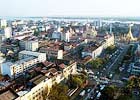 When
the Caretaker Government assumed power in 1958, a municipal commissioner was
appointed with the mission to clean up the city. The task was to educate the
public, to lay down necessary controls, to dredge and clear blocked drainage, to
rid sidewalks of encroaching shops, to repair old equipment and install new
machinery. The mission was a relative success and today Yangon is the proud
capital of this diverse land and is once more open to visitors from foreign
shores, this time though with open arms. When
the Caretaker Government assumed power in 1958, a municipal commissioner was
appointed with the mission to clean up the city. The task was to educate the
public, to lay down necessary controls, to dredge and clear blocked drainage, to
rid sidewalks of encroaching shops, to repair old equipment and install new
machinery. The mission was a relative success and today Yangon is the proud
capital of this diverse land and is once more open to visitors from foreign
shores, this time though with open arms.
Last changed: Saturday October 18, 2014
|
 The
founding story of Shwedagon reaches back to the days of the ‘Enlightenment’
of Gaudama Buddha. It was on the 49th day after the ‘Enlightenment’ when two
brothers, Taphussa and Bhallika, merchants from Ukkalapa in the land of Mon
people in lower Myanmar, came before Buddha. Buddha passed his hand over his
head and obtaining eight hairs, gave them to the brothers. Buddha, perceiving
that three previous Buddhas had their possessions enshrined in a pagoda on
Singuttara hill in the country of the two brothers, bade them to do likewise
with the ‘sacred hairs’.
The
founding story of Shwedagon reaches back to the days of the ‘Enlightenment’
of Gaudama Buddha. It was on the 49th day after the ‘Enlightenment’ when two
brothers, Taphussa and Bhallika, merchants from Ukkalapa in the land of Mon
people in lower Myanmar, came before Buddha. Buddha passed his hand over his
head and obtaining eight hairs, gave them to the brothers. Buddha, perceiving
that three previous Buddhas had their possessions enshrined in a pagoda on
Singuttara hill in the country of the two brothers, bade them to do likewise
with the ‘sacred hairs’. On
their return the king welcomed the hairs with great ceremony at Asitanzana,
north-west of present Yangon. No human knew the location of the previous
Buddha’s possessions but Sakka, King of the nats did and guided them to
Singuttara where Gautama Buddha's hairs were enshrined and a stupa consecrated
on the full moon day of Tabaung (March 6,c.588 B.C.)
On
their return the king welcomed the hairs with great ceremony at Asitanzana,
north-west of present Yangon. No human knew the location of the previous
Buddha’s possessions but Sakka, King of the nats did and guided them to
Singuttara where Gautama Buddha's hairs were enshrined and a stupa consecrated
on the full moon day of Tabaung (March 6,c.588 B.C.) In
the fifth century A.D. King Duttabaung paid homage at the Pagoda and in the 11th
century, King Anawratha of Bagan offered gold and silver umbrellas and built a
pagoda near the town of Twante across the Yangon River. (Dalla, which is now a
town on the bank opposite Yangon, was then located on the Twante Ridge and was
more important than Dagon. Dagon at that time lay in low lying often
water-logged land. Sule Pagoda, now in downtown Yangon, stood on a small island
in the swamp, to the west down to he Hlaing River and Yangon /River to the south
.The Shwedagon (then called Kyak Lagun in Mon) was reached across a causeway.)
In
the fifth century A.D. King Duttabaung paid homage at the Pagoda and in the 11th
century, King Anawratha of Bagan offered gold and silver umbrellas and built a
pagoda near the town of Twante across the Yangon River. (Dalla, which is now a
town on the bank opposite Yangon, was then located on the Twante Ridge and was
more important than Dagon. Dagon at that time lay in low lying often
water-logged land. Sule Pagoda, now in downtown Yangon, stood on a small island
in the swamp, to the west down to he Hlaing River and Yangon /River to the south
.The Shwedagon (then called Kyak Lagun in Mon) was reached across a causeway.) After
the collapse of Bagan in the 13th century and the rise of Mon power in the 14th
with the capital at Bago, Dagon became a place of some importance, though not as
a commercial port but as a centre of religious life. Dagon at that time was not
a walled city but a fort of logs.
After
the collapse of Bagan in the 13th century and the rise of Mon power in the 14th
with the capital at Bago, Dagon became a place of some importance, though not as
a commercial port but as a centre of religious life. Dagon at that time was not
a walled city but a fort of logs. Queen
Shin Saw Bu was the first to gild the Pagoda. She donated her weight in
gold to its gilding process and dedicated a vast expanse of land which virtually
covered the whole of modern Yangon. Her successor King Dhammazedi created the
stone inscriptions standing on Pagoda Hill as well as donating a huge bell which
a Portugese adventurer took away only to fall into the river, never to be
recovered. In 1539, Tabinshwehti, who had conquered Bago, placed the jewelled
finish on the pagoda’s spire.
Queen
Shin Saw Bu was the first to gild the Pagoda. She donated her weight in
gold to its gilding process and dedicated a vast expanse of land which virtually
covered the whole of modern Yangon. Her successor King Dhammazedi created the
stone inscriptions standing on Pagoda Hill as well as donating a huge bell which
a Portugese adventurer took away only to fall into the river, never to be
recovered. In 1539, Tabinshwehti, who had conquered Bago, placed the jewelled
finish on the pagoda’s spire. By
the end of the 16th century the Shwedagon Fair (by now an annual event) was
attracting people not only from Myanmar but also from distance lands such as
Laos and Cambodia. The Dagon Fair was one of the chief markets for overseas
trade rivalling Bago and Thanlyin. This and the fact that the Bago River was
silting up making it difficult for sea-going vessels to navigate, Dagon become
the port of choice.
By
the end of the 16th century the Shwedagon Fair (by now an annual event) was
attracting people not only from Myanmar but also from distance lands such as
Laos and Cambodia. The Dagon Fair was one of the chief markets for overseas
trade rivalling Bago and Thanlyin. This and the fact that the Bago River was
silting up making it difficult for sea-going vessels to navigate, Dagon become
the port of choice. After
the founding of the Shwedagon Pagoda, Alaungpaya's conquest of lower Myanmar is
the second most important event in the history of Dagon. May 1775 marks the
beginning of the modern town when Alaungpaya, to commemorate his victory,
changed its name from Dagon to Yangon, "Enmity exhausted."
After
the founding of the Shwedagon Pagoda, Alaungpaya's conquest of lower Myanmar is
the second most important event in the history of Dagon. May 1775 marks the
beginning of the modern town when Alaungpaya, to commemorate his victory,
changed its name from Dagon to Yangon, "Enmity exhausted." The
East India Company's government sent a combined force of nearly eleven thousand
men with forty pieces of artillery. On 10 May 1824 the fleet had anchored within
the bar upriver and landed on the 12th.
The
East India Company's government sent a combined force of nearly eleven thousand
men with forty pieces of artillery. On 10 May 1824 the fleet had anchored within
the bar upriver and landed on the 12th. By
November, general Maha Bandoola arrived in the neighbourhood of Yangon. He made
several attempts to evict the invading force stationed on the Pagoda but was
frustrated by the guns of the enemy fleet. On the 15th, the Myanmar army was
driven from its stronghold and retreated towards Danubyu where an enemy shell
killed Maha Bandoola.
By
November, general Maha Bandoola arrived in the neighbourhood of Yangon. He made
several attempts to evict the invading force stationed on the Pagoda but was
frustrated by the guns of the enemy fleet. On the 15th, the Myanmar army was
driven from its stronghold and retreated towards Danubyu where an enemy shell
killed Maha Bandoola.  The
Treaty of Yandabo was concluded on 24th February 1826. Yangon remained in
occupation till 8th December. The invading force weighed anchor on 9th December
with a detachment left behind to receive the final instalment of the indemnity.
Yangon was returned to the Myowun by general Campbell.
The
Treaty of Yandabo was concluded on 24th February 1826. Yangon remained in
occupation till 8th December. The invading force weighed anchor on 9th December
with a detachment left behind to receive the final instalment of the indemnity.
Yangon was returned to the Myowun by general Campbell. King
Thayawady decided that King Alaungpaya's town was too vulnerable to attack from
the river and that a new town should be built further inland, about a mile and a
quarter from the river. The Pagoda was worked into the defences of the town
and thus the Shwedagon formed the north-east corner of the town which was
named Aung Myei Aung Hnin, "Victory Soil, Victorious Ejector"
King
Thayawady decided that King Alaungpaya's town was too vulnerable to attack from
the river and that a new town should be built further inland, about a mile and a
quarter from the river. The Pagoda was worked into the defences of the town
and thus the Shwedagon formed the north-east corner of the town which was
named Aung Myei Aung Hnin, "Victory Soil, Victorious Ejector" Though
King Thayawady's town was occupied for residence, the old Yangon continued to be
populous. Commerce and industry and all connected with trade and the port were
still situated there. In the end, King Alaungpaya's town existed for only
ten years and in 1852, lower Myanmar was annexed by the British and a new
Yangon was planned.
Though
King Thayawady's town was occupied for residence, the old Yangon continued to be
populous. Commerce and industry and all connected with trade and the port were
still situated there. In the end, King Alaungpaya's town existed for only
ten years and in 1852, lower Myanmar was annexed by the British and a new
Yangon was planned. A
British force of 6000 men escorted by fifteen warships appeared at the mouth of
Yangon River on the 1st April 1852. On the 11th the ships crossed the bar and
took up position opposite the old town. The next day, Theinbyu, "the White
House Stockade" was taken. The British annexed lower Myanmar by a
proclamation dated 20th December 1852. On the 21st the proclamation was read in
Yangon.
A
British force of 6000 men escorted by fifteen warships appeared at the mouth of
Yangon River on the 1st April 1852. On the 11th the ships crossed the bar and
took up position opposite the old town. The next day, Theinbyu, "the White
House Stockade" was taken. The British annexed lower Myanmar by a
proclamation dated 20th December 1852. On the 21st the proclamation was read in
Yangon. Yangon,
become the model city in South-east Asia, but suffered great damage during the
Second World War. Its buildings, roads and drainage systems were destroyed and
insurgents added to the problem after Independence in 1948. This led to a
massive influx of refugees into the city which became covered with small shacks
of bamboo and thatch. Disease became rampant and the mortality rate increased
.Fires often broke out, destroying thousands of homes in the squatter slums.
Yangon,
become the model city in South-east Asia, but suffered great damage during the
Second World War. Its buildings, roads and drainage systems were destroyed and
insurgents added to the problem after Independence in 1948. This led to a
massive influx of refugees into the city which became covered with small shacks
of bamboo and thatch. Disease became rampant and the mortality rate increased
.Fires often broke out, destroying thousands of homes in the squatter slums. When
the Caretaker Government assumed power in 1958, a municipal commissioner was
appointed with the mission to clean up the city. The task was to educate the
public, to lay down necessary controls, to dredge and clear blocked drainage, to
rid sidewalks of encroaching shops, to repair old equipment and install new
machinery. The mission was a relative success and today Yangon is the proud
capital of this diverse land and is once more open to visitors from foreign
shores, this time though with open arms.
When
the Caretaker Government assumed power in 1958, a municipal commissioner was
appointed with the mission to clean up the city. The task was to educate the
public, to lay down necessary controls, to dredge and clear blocked drainage, to
rid sidewalks of encroaching shops, to repair old equipment and install new
machinery. The mission was a relative success and today Yangon is the proud
capital of this diverse land and is once more open to visitors from foreign
shores, this time though with open arms.